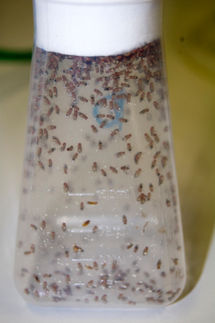The code of codes: Scientists discover parallel codes in genes
The genetic code is nearly optimal for harboring information
Researchers from The Weizmann Institute of Science report the discovery of two new properties of the genetic code. Their work, which appears online in Genome Research, shows that the genetic code - used by organisms as diverse as reef coral, termites, and humans - is nearly optimal for encoding signals of any length in parallel to sequences that code for proteins. In addition, they report that the genetic code is organized so efficiently that when the cellular machinery misses a beat during protein synthesis, the process is promptly halted before energy and resources are wasted.
"Our findings open the possibility that genes can carry additional, currently unknown codes," explains Dr. Uri Alon, principal investigator on the project. "These findings point at possible selection forces that may have shaped the universal genetic code."
The genetic code consists of 61 codons-tri-nucleotide sequences of DNA-that encode 20 amino acids, the building blocks of proteins. In addition, three codons signal the cellular machinery to stop protein synthesis after a full-length protein is built.
While the best-known function of genes is to code for proteins, the DNA sequences of genes also harbor signals for folding, organization, regulation, and splicing. These DNA sequences are typically a bit longer: from four to 150 or more nucleotides in length.
Alon and his doctoral student Shalev Itzkovitz compared the real genetic code to alternative, hypothetical genetic codes with equivalent codon-amino acid assignment characteristics. Remarkably, Itzkovitz and Alon showed that the real genetic code was superior to the vast majority of alternative genetic codes in terms of its ability to encode other information in protein-coding genes-such as splice sites, mRNA secondary structure, or regulatory signals.
Itzkovitz and Alon also demonstrated that the real genetic code provides for the quickest incorporation of a stop signal-compared to most of the alternative genetic codes-in cases where protein synthesis has gone amiss (situations that scientists call "frameshift errors"). This helps the cell to conserve its energy and resources.
"We think that the ability to carry parallel codes-or information beyond the amino acid code-may be a side effect of selection for avoiding aberrant protein synthesis," says Itzkovitz. "These parallel codes were probably exploited during evolution to allow genes to support a wide range of signals to regulate and modify biological processes in cells."
Original publication: Itzkovitz, S. and Alon, U. ; "The genetic code is nearly optimal for allowing arbitrary additional information within protein-coding sequences."; Genome Res. 2007.
Most read news
Other news from the department science

Get the life science industry in your inbox
By submitting this form you agree that LUMITOS AG will send you the newsletter(s) selected above by email. Your data will not be passed on to third parties. Your data will be stored and processed in accordance with our data protection regulations. LUMITOS may contact you by email for the purpose of advertising or market and opinion surveys. You can revoke your consent at any time without giving reasons to LUMITOS AG, Ernst-Augustin-Str. 2, 12489 Berlin, Germany or by e-mail at revoke@lumitos.com with effect for the future. In addition, each email contains a link to unsubscribe from the corresponding newsletter.






















































